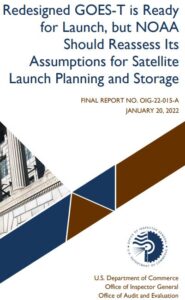NOAA Should Reassess Geostationary Satellite Launch Plans

The Commerce Department Inspector General warned last week that the National Oceanic and Atmospheric Administration may be increasing risk in the development of its environmental satellites.
OIG auditors did not ask for a delay of GOES-T’s launch, they did ask NOAA to conduct an analysis of alternatives regarding whether to continue the GOES program’s approach of “managing schedules toward the earliest possible launch dates.” The OIG asked, for example, why the GOES program “made changes to the spacecraft propulsion system and test campaign” that ultimately “did not simulate a general mission profile from liftoff to orbit.”
“This means that the GOES-T satellite configuration that entered the testing phase was not the same configuration that will launch and fly on-orbit, which is a standard in the NOAA and NASA spaceflight- GOLD Rule to “test as you fly—fly as you test,” the audit states. “This rule holds that testing of all critical mission-operation elements (such as the propulsion system) as they will be flown greatly reduces the risk of negative impacts upon mission success, whether from partial or full loss of capability.”
NOAA/NESDIS agreed with all five recommendations from auditors, including that the agency conducts an analysis of alternatives regarding how to manage satellite launch schedules.
Summary of OIG Audit of NOAA GOES schedule, testing, and storage.
Redesigned GOES-T is Ready for Launch, but NOAA Should Reassess Its Assumptions for Satellite Launch Planning and Storage
OIG-22-015-A
WHAT WE FOUND
We found the following:
I. The Program works toward the earliest achievable launch dates at
potentially increased development risk.
II. NESDIS is planning GOES launches sooner than its policy requires
without analyzing the costs.
III. NESDIS assumes ground storage of satellites is not viable, but has not
formally studied tradeoffs.
WHAT WE RECOMMEND
We recommend that the NOAA Deputy Under Secretary for Operations
ensure that the Assistant Administrator for Satellite and Information
Services do the following:
- Conduct an analysis of alternatives or similar assessment to
determine whether to continue the Program’s approach of managing
schedules toward the earliest possible launch dates. - Conduct a cost-benefit analysis of selected geostationary coverage
availability thresholds, and update its geostationary launch policy as
appropriate. - Determine the cost of operating spare satellites on orbit versus
alternative options, including consideration of constellation longevity
and satellite development risks, to help inform optimal acquisition and
launch strategies. - Assess the cost effectiveness of satellite ground and on-orbit storage
options using current cost, schedule, and technical performance data
that can inform NESDIS satellite storage decisions. - On future satellite series, document storage option considerations
early in the acquisition process to optimize satellite storage
alternatives.
Link to complete OIG report
Note, the analysis was finished later 2021, and at that time Luach of GOES-T was scheduled for February 2022, which has since been moved to March 1, 2022